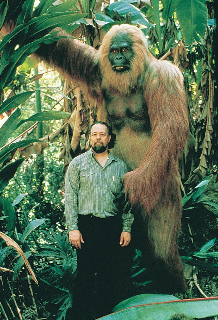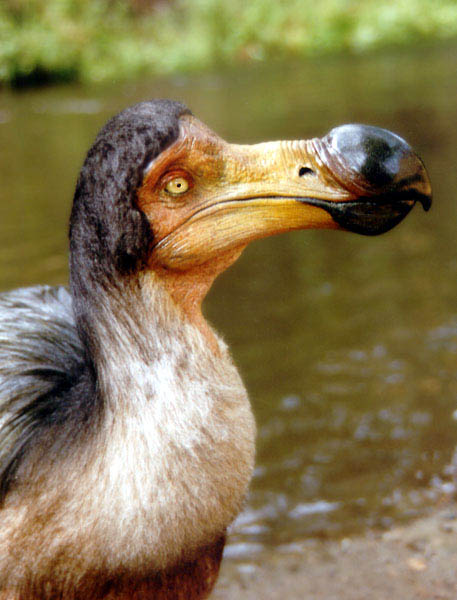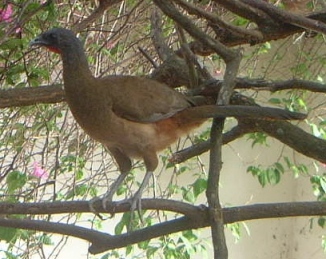What Did A Dodo Look Like?
Posted by: Loren Coleman on June 14th, 2008
Besides my recent Cryptomundo postings on the dodo and the moa-nalo, I have written other past entries here, which have reviewed the following often cryptic flightless bird species: elephant bird, more dodo, terror birds, more terror birds, moa, more moa, and takahē.
In line with a question during an earlier discussion about how might have the dodo really appeared, the famed artist and Hollywood special effects man Bill Munn, well-known for his reconstruction of Gigantopithecus (below), contacted me.

Munns wrote: “I have done scientific reconstructions of the Dodo (of how they may have looked) with all coloration based on actual descriptions and the head sculpted from a skull cast provided by the Harvard Museum of Natural History.”
The following reconstruction is what Bill Munns created of the dodo, and may be the closest thing we have to how a living dodo looked in the wild.

Additionally, Munns attached a portrait photo of Aepyornis maximus, the elephant bird, based on a skull cast of the best specimen in the Natural History Museum of Paris, done for a full body reconstruction that the museum now has in its collection.

Speaking of what extinct birds might have looked like, Darren Naish has a new somewhat technical blog entitled “You’re Not a Protophorusrhacid,” with some words about the following reconstruction:

Rufous-vented Chachalaca.
About Loren Coleman
Loren Coleman is one of the world’s leading cryptozoologists, some say “the” leading living cryptozoologist. Certainly, he is acknowledged as the current living American researcher and writer who has most popularized cryptozoology in the late 20th and early 21st centuries.
Starting his fieldwork and investigations in 1960, after traveling and trekking extensively in pursuit of cryptozoological mysteries, Coleman began writing to share his experiences in 1969. An honorary member of Ivan T. Sanderson’s Society for the Investigation of the Unexplained in the 1970s, Coleman has been bestowed with similar honorary memberships of the North Idaho College Cryptozoology Club in 1983, and in subsequent years, that of the British Columbia Scientific Cryptozoology Club, CryptoSafari International, and other international organizations. He was also a Life Member and Benefactor of the International Society of Cryptozoology (now-defunct).
Loren Coleman’s daily blog, as a member of the Cryptomundo Team, served as an ongoing avenue of communication for the ever-growing body of cryptozoo news from 2005 through 2013. He returned as an infrequent contributor beginning Halloween week of 2015.
Coleman is the founder in 2003, and current director of the International Cryptozoology Museum in Portland, Maine.










Very nice.
Wonderful! (I’d like to see Munns make a reconstruction of a teratorn)
I LOVE the DODO, so this was very nice to see. But I want to see MORE of the bird. What about the all important wings, tail and feet? And the colors thereof? I have a fantasy that the dodos that were taken live back to England or Europe reproduced (at someone’s rich estate) and a few still exist somewhere…..
Loren:
Thank you for the nice article.
Purricat:
I am gathering my photos of all old work, including the dodo, for a new web gallery of all my creature work, and more photos of the dodo will be there. For an excellent description of their true appearance, which I referenced in my model, you may look to Errol Fuller’s fine book, “Extinct Birds”, which has an excellent chapter on the dodo, including superb photos of a full skeleton and mummified feet.
Vimania:
I still have a long list of animals I wish to recreate, and the teratorn is definitely on the list, along with a “Terror Bird” (Phorasrachus), Diatrima, the Moa, and the Mirhunga .
Bill
Ive got that book, its very good.
will you do a soiltare and a broad beaked parrot to make friends with your dodo?
Bill,
those are truly beautiful recreations.
I hope one day you may consider gathering together a porfolifo or book of these models for all of us-I can never get enough crypto-books!
Regards,
Gary.
Dodos do look like they would be good on Thanksgiving though. Damn Spanish conquistadors!
Tengu:
I’d actually love to do models of just about everything in Mr. Fuller’s book. One of my future ambitions.
Gary the Cat:
The website will be a start, and hopefully will be online in a week or two. It will have more of the dodo, the elephant bird, archeopteryx, some of my dinosaur models (including a brachiosaurus with a trunk), lots of curious stuff.
ClassicRocker 30:
If I recall, the historical descriptions of sailors taking dodos for food reported it didn’t taste good, probably like the hoatzin today, so while there was a lot of meat, not much taste.
But the elephant bird would have been a real meal. It’s drumstick bone is about 24″ long.
Bill
Bill Munns- Thank you for sharing these with us. They are AMAZING. That dodo replica is a real treat to see. I know it is not a bird, but I would love to see a Japanese Honshu Wolf recreation. I’d like to propose that animal for your list if you don’t mind!
ClassicRocker 30- As far as dodo meat is concerned, indeed it wasn’t known to be very tasty and was also a bit tough. More than hunting for food, it was introduced animals that did a great amount of damage to the dodo. One animal in particular, a type of macaque, did spectacular damage due to its appetite for the dodo’s eggs, and the ease with which these eggs could be obtained (walk right up and take them). Pigs that were brought to the island also caused a lot of trouble. Then there were cats and dogs, both of which usually have an impact when introduced to a new habitat.
Thanks for sharing your remarkable artwork, Bill Munns.
As emblematic as the Dodo is (was), it should be kept in mind that it was only one of several bird species (not to mention the other species of unique reptiles and tortoises known to have been living there as well) on Mauritius, perhaps dozens though in all likelyhood we’ll never fully know, of species of other birds that became extinct on that particular island due to overhunting and habitat impacts, including a number of different duck varieties. And that this extinction of bird species was re-enacted on virtually every one of the larger Mascarene Islands of the Indian Ocean, characterized by their uniquely adapted species, as these islands were volcanic in origin (i.e: never connected to one another) and seperated by fairly large distances, and therefore in fairly complete isolation, and each a really unique experiment in natural selection…and so the large land birds on these other islands may or may not have been evolved from doves, though perhaps from ibis, or parrots or who knows what…
I’m sorry if I misinterpreted the last bit of this article, but it seems to me that you are referring to the Rufous-vented Chachalaca (aka cocrico) as being extinct, but it is not, and is in fact one of the national birds of my country, Trinidad & Tobago,
I dunno, but I think those were Photoshopped. . .
🙂
Mr. Munns, thank you for sharing these wonderful pics with us. Looking forward to seeing more full-image photos of your ‘babies’ 🙂
PS: That dodo looks rather sad, perhaps it is pondering the fate of its species. Wonder if in a million years from now there will be replicas of homo sapiens displayed on the museums of the sentient cockroaches that will take over the Earth after us 😉
Bill Munns is up to something. He’s the only one that uses description and I love his theory on the Sauropods. 🙂
I wrote a paper about what the dodo looks like. This restoration is OK but could be improved. You can read the paper here.
Since this the following comments apply. The best evidence for the color of the wings is white.
The plumage was textured like a sort of gosling according to one description, downy but not hairy like a mammal.